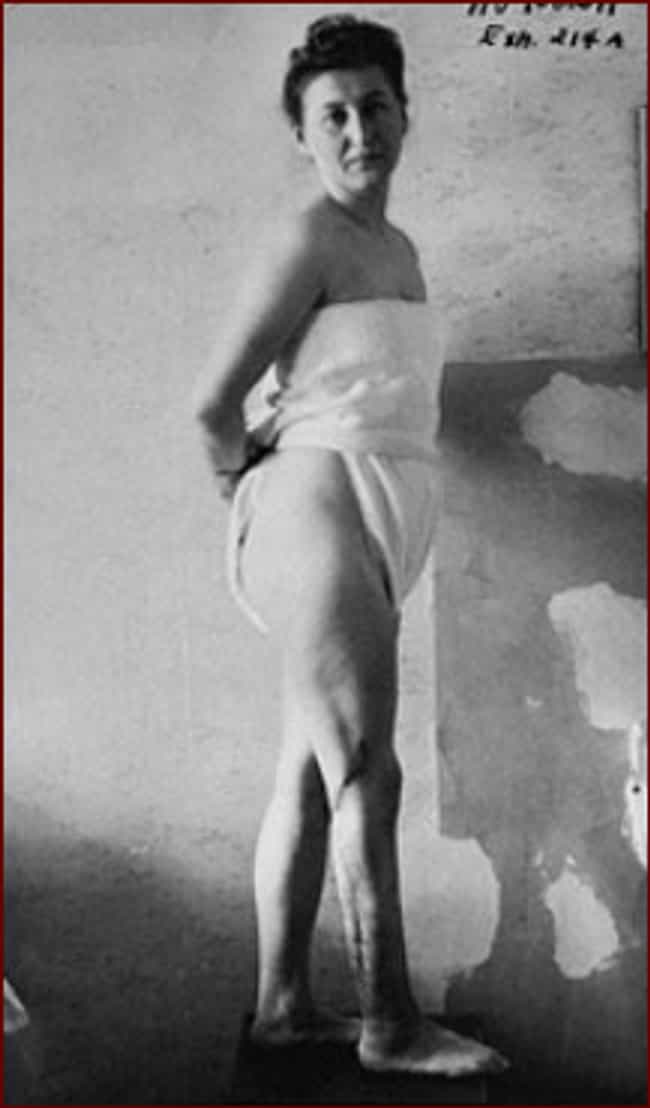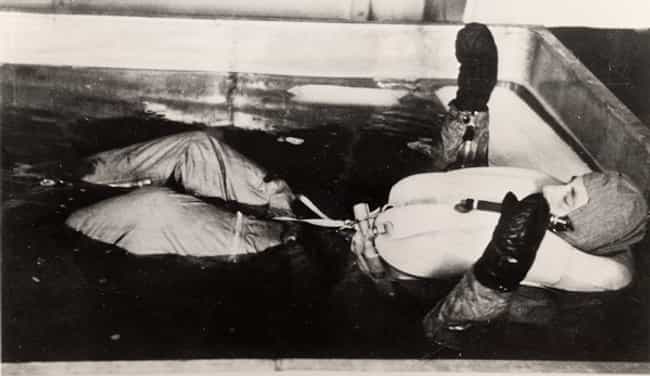At their best, scientists represent the best in humanity: intelligence, curiosity, and skeptical rigor. This allows scientists to do things that ordinary people wouldn’t be allowed to get away with. If a random person burst into your house with a bubbling test tube and shouted “Quick! Drink this!” you’d call the police. Put that person in a white lab coat, though, and you’ll only delay long enough to thank them for coming in the nick of time.
Scientists are human, however, and humans who’ve been given that level of trust sometimes prove to be the last people in the world who should be trusted.
From the the Nazis to America’s own horrific misdeeds, here are four of the most evil science experiments ever carried out.
Warning: This article contains details of experiments carried out with varying degrees of consent. If this is the sort of thing that upsets you, congratulations on not being a monster.
Evil Science Experiments: The Nazis
Nazi doctors tried to lighten the eyes of children by injecting them with dye. Image Source: Edit International
Almost any list of “X Most Evil Whatevers” is pretty much obligated to have a bunch of Nazis on it, even if it’s just a list of evil cupcake recipes. In non-consensual medical experiments of dubious scientific value, however, the Nazis really outdid themselves. Never has so much that was so bad been done for the enlightenment of so few for such little identifiable purpose.
At Auschwitz, Dr. Josef Mengele injected dye into the eyes of children to see if he could permanently change their color. He also famously tried to create conjoined twins by stitching his patients together.
Thank your lucky stars it didn’t work, because can you imagine if the Third Reich had perfected Siamese twin technology in time to win the war? Their elite Dopplesoldaten would have been unstoppable!
In 1942, Nazi doctors in Baranowicze, Poland strapped a young boy into a chair and repeatedly hit his head with a mechanized hammer.. It turns out that one out of one test subjects react negatively to this.
At the Ravensbrück women’s camp, the effectiveness of sulfonamide, a synthetic antibiotic, was tested on prisoners. Their arms and legs were gashed and blood supply was cut off to simulate battle wounds. Then the wounds were treated with bacteria and—five will get you ten—rubbed with ground glass because why not?
We’re not showing you pictures of wounds sustained in Ravensbrück. Here are some sleepy puppies. They’re twins, also! Image Source: Fanpop
The Nazi doctors who didn’t escape to South America were put on trial after the war. Some, mostly administrators, were acquitted. The guilty were given sentences ranging from ten years to death by hanging. So…happy ending?
Next up: What happens when you remove the left arm and attach it to the right side…
How One Covert Japanese Unit Killed Hundreds Of Thousands Of People
Unit 731 of the Japanese army was tasked with developing advanced germ-warfare techniques–and making the world a worse place in general.
Their greatest hits included the deliberate release of plague-infected fleas in Manchuria to kill as many people as possible. The targets were all civilians who played no part in anti-Japanese resistance. The Imperial Japanese Ministry of Gratuitous Evil could not be reached for comment.
Unit 731 began in 1931 as a disease prevention unit. By 1935, however, the unit had been folded into the Kwangtung Army in Manchuria and was conducting experiments so horrific that it’s difficult to imagine why their headquarters didn’t just fold up like the house in Carrie and disappear behind an event horizon.
The scale of the operation was huge: hundreds of thousands of people were killed in plague, anthrax, and cholera outbreaks started by the unit, including a single plague attack that the Chinese government estimates killed 580,000 people. An only somewhat smaller number of people were killed in the unit’s other experiments…
For at least ten years, Unit 731 cultivated wild strains of disease in human patients to increase their virulence. Infected patients who succumbed quickly to particularly lethal strains were bled to death and their blood was used to infect the next crop of prisoners.
Prisoners were vivisected without anesthesia, limbs were frozen and thawed to study gangrene, left arms were cut off and grafted to the right side of the body, and sections of vital organs were removed piece-by-piece to study the progress of the unit’s pet diseases. Unit 731 was one twirled mustache away from starting work on a Dr. Strangelove-style doomsday weapon when the Allies rolled in and pulled the plug.
When the Soviets defeated the Kwangtung Army, they put the perpetrators on trial, sentencing them to between two and 25 years of penal servitude. The U.S. bitterly opposed these trials, refused to acknowledge their legitimacy, and offered immunity to practically every Unit 731 member who could be identified including the unit commander, Shiro Ishii.
At least one former member of the unit, Masami Kitaoka, found post-war work with Japan’s National Institute of Health Sciences, where he spent nine years infecting mental patients with typhus to see what happened.
See all the grim details of Unit 731 in this recent documentary:
http://www.youtube.com/watch?v=rWu4te-55Ko
Next up: Which major U.S. companies and universities actually funded horrific experiments on humans…
The U.S. Tests A Chemical Weapon On Its Own People–And The Perpetrator Walks Free
Albert Kligman. You might recognize him as the man whose product, Retin-A, helped get rid of your acne, but to some prisoners, he was the man who made their lives a living hell. Image Source: Tevi
In 1951, American dermatologist Albert Kligman reported to work at Pennsylvania’s Holmesburg prison to study, of all things, ringworm.
Realizing the potential of the inmate population, and apparently forgetting literally everything he ever learned about medical ethics, Kligman eventually expanded his “research” into live drug trials, pathogen testing, and exposing inmates to dioxin, the active ingredient in Agent Orange, the chief chemical used in the United States’ herbicidal warfare program in Vietnam.
Over the course of 23 years, Kligman obtained grants from the US Army, Dow Chemical, and Johnson & Johnson, as well as academic support from the University of Pennsylvania, to research the effects of some of the most dangerous chemicals in his arsenal on people confined under terms that render the idea of “informed consent” a grisly joke.
By the time he finished, hundreds of patients had been knowingly infected with herpes, staph, athlete’s foot, and dioxin.
A Vietnamese child who has suffered birth defects likely caused by dioxin/Agent Orange. Image Source: Business Insider
As with the other entries on this list, Kligman’s results were of limited value. Those who reviewed his work found it to be so sloppy and riddled with conflicting data that it was excluded from consideration by the Food and Drug Administration.
Essentially, Kligman spent over two decades torturing prison inmates, and his results weren’t good enough for government work. Kligman managed to evade punishment and live to just short of 94. To the end of his life, he swore he did nothing wrong.
Evil Science Experiments: The Results Of Injecting People With The Ingredients Of Nuclear Bombs
What plutonium can do in a nuclear bomb–and this is what was actually injected into subjects’ bodies. Image Source: Wikimedia Commons
In the ’50s and ’60s, there was hardly a quicker way to get your research funded by the U.S. government than to pitch the idea of exposing people (especially minorities) to ridiculous amounts of radiation to see what would happen. Some of the highlights:
As part the program to develop nuclear weapons, unsuspecting soldiers and patients at a Chicago hospital were injected with some of the weapons’ chief ingredient: plutonium. Unsurprisingly, only about one in four lived long enough to hear about what had been done to them.
Cornelius Rhoads was widely hailed as a hero during his lifetime. Image Source: elmuertoquehabla.blogspot.com
Dr. Cornelius Rhoads, cancer researcher and future member of the Atomic Energy Commission, injected Puerto Ricans with active cancer cells to monitor the results–they, of course, died.
According to a cheery note written by Rhodes: “The Porto Ricans (sic) are the dirtiest, laziest, most degenerate and thievish race of men ever to inhabit this sphere…I have done my best to further the process of extermination by killing off eight and transplanting cancer into several more.”
Dr. Eugene Saenger, under the guise of treatment, exposed dozens of African-American patients to over 20,000 x-rays’ worth of radiation. It was enough to cause severe pain, bleeding, and at least 20 identifiable deaths.
In the 90s, the families of some of Saenger’s patients sued him, eventually winning a $3.6 million settlement.
More of Horrifying Nazi Experiments on Humans
Heinrich Himmler ordered a Nazi doctor to artificially inseminate concentration camp prisoners though various experimental methods. Dr. Carl Clauberg artificially inseminated about 300 women at Auschwitz, who were strapped down and taunted mercilessly. Clauberg told his victims that he had used animal sperm to create a monster inside of them.




Comments
Post a Comment